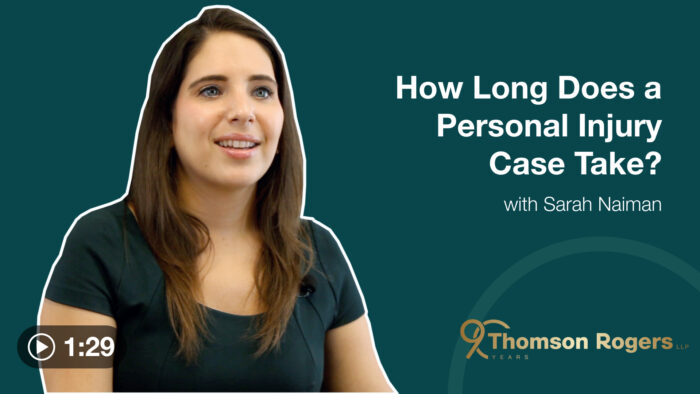The Use of Discovery Transcripts at Trial
Author(s): L. Craig Brown
September 28, 2012
Preparation for Trial
An obvious but sometimes overlooked requirement for the use of discovery transcripts at trial is that the transcripts exist in a form that is acceptable to the court. That means they need to be ordered well in advance of trial and that a court copy signed by the reporter be obtained in case the transcript needs to be formally proved.
An indexed transcript brief should be prepared. It should contain:
- transcripts of each party’s examination for discovery;
- a summary of the transcripts;
- a list of undertakings and the answers to those undertakings; and
- transcripts from any related proceedings.1
The Rule
The use of discovery transcripts in Ontario is governed by Rule 31.11 of the Rules of Civil Procedure. At trial, any party may read into the record all or part of the examination for discovery of an adverse party to prove facts in issue. Rule 31.11(1) provides:
Reading in Examination of Party
31.11(1) At the trial of an action, a party may read into evidence as part of the party’s own case against an adverse party any part of the evidence given on the examination for discovery of,
- the adverse party; or
- a person examined for discovery on behalf or in place of, or in addition to the adverse party, unless the trial judge orders otherwise,
if the evidence is otherwise admissible, whether the party or other person has already given evidence or not.
This is a significant change from the former rule which applied only to “opposite” parties. This was sometimes interpreted to exclude co-defendants.
Another change to the rule permits discovery evidence to be read in “whether the party or person has already given evidence or not”. The practice in Ontario before Rule 31.11(1) was enacted required that the witness whose discovery evidence was to be read in to be confronted with the evidence before reading in and during cross-examination. Under the new rule, where the plaintiff’s answers on cross-examination at trial are not responsive, the defendant may read into evidence his answers given on discovery.2
Evidence read into the record from a party’s examination for discovery are normally treated as admissions by that party, however, there may be occasions when a party’s knowledge of the event he/she is “admitting” is so peripheral that it may offend the hearsay rule.3
The discovery evidence of an adverse party may also be read into the record to impeach a witness. Rule 31.11(2) provides:
Impeachment
31.11(2) The evidence given on an examination for discovery may be used for the purpose of impeaching the testimony of a deponent as a witness in the same manner as any previous inconsistent statement by that witness.
No similar provision appeared prior to the enactment of Rule 31.11(2) but the practice existed under common law rule. If it is intended to use discovery evidence to impeach a witness, the provisions of Sections 20 and 21 of the Ontario Evidence Act must be complied with when examining the witness in connection with that evidence.4
Sections 20 and 21 of the Ontario Evidence Act provide:
Examination of witnesses, proof of contradictory written statements
- A witness may be cross-examined as to previous statements made by him or her in writing, or reduced into writing, relative to the matter in question, without the writing being shown to the witness, but, if it is intended to contradict the witness by the writing, his or her attention shall, before such contradictory proof is given, be called to those parts of the writing that are to be used for the purpose of so contradicting the witness, and the judge or other person presiding at any time during the trial or proceeding may require the production of the writing for his or her inspection, and may thereupon make such use of it for the purposes of the trial or proceedings as he or she thinks fit.
Proof of contradictory oral statements
- If a witness upon cross-examination as to a former statement made by him or her relative to the matter in question and inconsistent with his or her present testimony does not distinctly admit that he or she did make such statement, proof may be given that the witness did in fact make it, but before such proof is given the circumstances of the supposed statement sufficient to designate the particular occasion shall be mentioned to the witness, and the witness shall be asked whether or not he or she did make such statement.
It is therefore important prior to trial to characterize whether the evidence which you intend to read goes to prove an admission of fact or to impeach credibility. In the latter case, the relevant portions of the discovery evidence must ordinarily be put to the witness in box and not simply read into the record at the close of the case (subject to the exception described above). In these instances, the discovery transcript is treated as a prior inconsistent statement to which the rule in Browne v.Dunn also applies. The procedure developed under the rule in Browne v. Dunnrequires that counsel must, prior to putting the statement to the witness for the purpose of contradicting him or her, call the witness’ attention to the contradiction contained in the document.5
The process also requires that the witness specifically be asked whether he or she did make the statement. If the witness denies making the statement, it must be proved by counsel tendering it as an inconsistency.
In addition to the obligation to put an “inconsistent statement” to a witness in cross-examination, the statement must in fact be “inconsistent”. If there is not a real inconsistency between the prior statement and the evidence given by that witness at trial, then the cross-examination on the prior statement will not be allowed to proceed.6
Section 20 and 21 of the Ontario Evidence Act require that the prior inconsistent statement be “relative to the matter in question” leading to serious doubts as to whether inconsistent statements relating to collateral matters, which are being used only to impeach credibility, are admissible under the Act. In other words, there is a strong argument that discovery transcripts may only be used to impeach a witness where the subject of the statement being read to the witness are related to the substantive matters in the litigation.7
When evidence from a discovery transcript is read into the record, an adverse party may ask the trial judge to direct that additional portions of the transcript be read in which are so closely connected to the first portion that the additional portion is required in order to accurately reflect the evidence given on discovery.8
This common law rule is encoded in Rule 31.11(3) as follows:
Qualifying Answers
31.11(3) Where only part of the evidence given on an examination for discovery is read into or used in evidence, at the request of an adverse party the trial judge may direct the introduction of any other part of the evidence that qualifies or explains the part first introduced.
If the answer to a question put on discovery is complete in itself, this rule does not entitle an adverse party to have read in other parts which explain only why the answer was given. It is for the adverse party to request that additional portions of the transcript be read in at trial, and if he or she fails to do so, the court will not intervene.9
If the request is directed to the trial judge, it must be made at the time the evidence is being read in and certainly before the tendering party closes his case.10
It is improper for counsel to refer the trial judge to those parts of the trial evidence or to discovery evidence of another witness that enlarges upon or explains the evidence being read into the record except in closing argument.11
It is important to note that the plaintiff is not entitled to prove its case against one party by reading in as evidence the examination for discovery of a co-defendant.12
It may be possible for a party to read in the evidence of portions of its own discovery. Rule 31.11(6) provides:
Unavailability of Deponent
31.11(6) Where a person examined for discovery,
- has died;
- is unable to testify because of infirmity or illness;
- for any other sufficient reason cannot be compelled to attend at the trial; or
- refuses to take an oath or make an affirmation or to answer any proper question,
any party may, with leave of the trial judge, read into evidence all or part of the evidence given on the examination for discovery as the evidence of the person examined, to the extent that it would be admissible if the person were testifying in court.
Factors for interpreting this part of the rule are found in 31.11(7) set out below:
31.11(7) In deciding whether to grant leave under subrule (6), the trial judge shall consider,
- the extent to which the person was cross-examined on the examination for discovery;
- the importance of the evidence in the proceeding;
- the general principle that evidence should be presented orally in court; and
- any other relevant factor.
Common Mistakes
Evidence read in by a party becomes part of its case. Care must be exercised in choosing those portions of the discovery evidence to be read in since that evidence, if unfavourable, can be relied upon by the court to support a finding against the tendering party.13
It is helpful to have more than one person review the proposed discovery read-ins for their real value to the case. It may turn out that the excerpt contains a mixture of evidence, some of which is helpful to the opposite party and which on balance outweighs the positive value of the other parts of the evidence.
Another common mistake of counsel attempting to use discovery transcripts as prior inconsistent statements in cross-examination is to fail to identify a real inconsistency. It is not enough for trial evidence to be different from discovery evidence if the differences can be reconciled or even explained. In situations where witnesses are able to reconcile the two statements, it is cross-examining counsel who loses credibility.
Getting the Transcript to the Jury
It is useful to review discovery transcripts in electronic form so that questions to be read in can be cut and pasted into a single document in logical order. It is also useful to create headings for distinct sections of the transcript on a particular topic. This compilation of discovery read-ins can be projected on a screen for the judge and jury to follow as the questions and answers are being read into the record. It can then be tendered to the court to be made an exhibit so that the jury has a written copy of the discovery read-ins.
In order that the process of reading in goes smoothly, it is prudent to provide opposing counsel with a copy of the proposed read-ins to permit any argument with respect to the admissibility of the transcript sections to be made prior to the actual reading in. The disadvantage of this is that it provides opposing counsel with more time to search the transcript for qualifying answers.
Attached are discovery questions which were read in during a recent (2011) trial in Oshawa.
1 The Art and Science of Advocacy, John Olah, Carswell at 7.2(c).
2 C.I.B.C. v. Int. Harvester Credit Corp. of Can. (1985), 50 O.R. (2d) 318.
3 Esson v. A.M.S. Forest Products Ltd. (1993), 18 C.P.C. (3D) 320.
4 Int. Corona Resources Ltd. v. LAC Minerals Ltd. (1986), 8 C.P.C. (2d) 39 H.C.J. per R.E Holland, J. at p.41, 53 O.R. (2d) 737.
5 The Law of Evidence in Canada, Alan W. Bryant et al, Third Edition, 2009, LexisNexis, at Section 16.151.
6 The Law of Evidence in Canada at Sections at Sections 16.154 and 155.
7 The Law of Evidence in Canada at Section 16.156.
8 Canary and Zerbinos v. Vested Estates Ltd. [1931] 1 D.L.R. 997 (B.C.C.A.), at p.997;
Sterling Trusts Corp. et al v. Postma et al, [1965] S.C.R. 324.
9 Basil v. Spratt (1918), 44 O.L.R. 155 at p.169 (C.A.).
10 Edwards v. Arbeau (1962), 38 D.L.R.(2d) 319 (N.B.C.A.).
11 Int. Corona Resources Ltd. v. LAC Minerals Ltd. (1986), 8 C.P.C. (2d) 39 H.C.J. per R.E Holland, J. at p.42.
12 Bank of Ottawa v. Harty (1906), 12 O.L.R. 218 at p.219;
Bank of Montreal v. Scott (1904), 3 O.W.R. 523 (Div. Ct.) per Street, J. at p.523.
13 Capital Trust Corp. v. Fowler (1921), 50 O.L.R. 48; 64 D.L.R. 298 (C.A.) per Hodgins, J.A. at pp.59-90.
Share this






